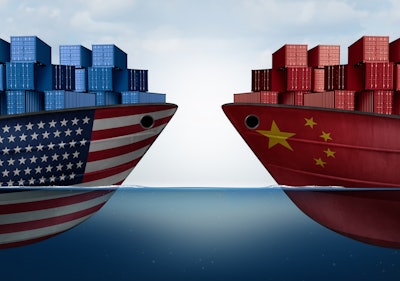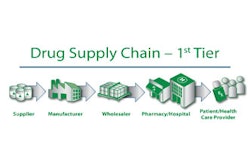
Is all fair in a trade war? When it comes to machine building and manufacturing, we are about to find out, as new tariffs and negotiations continue between the U.S. and China.
The China-United States trade war “unofficially” started on July 6, 2018, when the Trump Administration imposed 25 percent tariffs on more than 800 Chinese products, ranging from industrial machinery to medical devices to auto parts and components, which collectively, are worth about $34 billion. That action led to a reaction from China, which responded with similar tariffs—ranging from 5 to 25 percent—on U.S. exports. From there, it escalated.
In August, the office of the U.S. Trade Representative (USTR) published a second list of approximately $16 billion worth of Chinese imports that will be subject to a 25 percent additional tariff as of August 23, 2018, and a third list targeting $200 billion that will be subject to a 25 percent additional tariff as early as mid-September. In these actions, the USTR cites the need to protect national security and the intellectual property (IP) of American businesses, as well as to help reduce the U.S. trade deficit with China.
This all began in March 2018 when USTR released the findings of its exhaustive investigation of Section 301 of the Trade Act of 1974, that found China’s acts, policies and practices related to technology transfer, IP and innovation, to be unreasonable and discriminatory and burden U.S. commerce.
Specifically, the Section 301 investigation revealed:
-
China uses joint venture requirements, foreign investment restrictions and administrative review and licensing processes to require or pressure technology transfer from U.S. companies.
-
China deprives U.S. companies of the ability to set market-based terms in licensing and other technology-related negotiations.
-
China directs and unfairly facilitates the systematic investment in, and acquisition of, U.S. companies and assets to generate large-scale technology transfer.
-
China conducts and supports cyber intrusions into U.S. commercial computer networks to gain unauthorized access to commercially valuable business information.
“The Trump Administration continues to urge China to stop its unfair practices, open its market and engage in true market competition,” said U.S. Trade Representative Robert Lighthizer, in a statement. “We have been very clear about the specific changes China should undertake. Regrettably, instead of changing its harmful behavior, China has illegally retaliated against U.S. workers, farmers, ranchers and businesses.”
Essentially, the tariffs are being used as leverage to force China into compliance of fair trade. But the question remains: Is this fair to U.S. manufacturers?
Targeting food processing and packaging machinery
According to TradeMoves, an international trade and customs advisory firm, right now, there is a risk to manufacturers’ supply chain and to their bottom line.
U.S. OEMs and manufacturers “will pay higher prices on any imports they get from China,” says Shawn Jarosz, TradeMoves president and founder. “And, if OEMs are selling machines in China, their customers will pay up to 25 percent more on their imported U.S.-made equipment, so we expect OEMs will have to either lower prices or absorb some of that additional cost to compete with equipment made in other countries.”
TradeMoves recently conducted a study for PMMI, The Association for Packaging and Processing Technologies, which outlines the impact that the trade war will have on PMMI’s OEM members, as well as their manufacturing customers.
As a result of U.S. trade actions this year, costs for domestic and imported steel and aluminum have increased in the United States. This is due to an additional 25 percent tariffs on certain steel products and 10 percent tariffs imposed on certain aluminum products imported into the U.S. from all countries, including China. In addition, parts, inputs, and select food processing and packaging machinery originating from China may be included on various tariff “hit” lists that the U.S. is targeting for 25 percent additional duties.
China’s countermeasures include proposed tariffs on products that include U.S.-manufactured food processing and packaging equipment, as well as various U.S.-origin parts/inputs. To gauge what this means to the packaging and processing industry, TradeMoves reviewed 2017 U.S. exports to China—looking specifically at equipment made by PMMI members that is now included on China’s tariff retaliation lists.
For example, dairy machinery, which generated $1.95 million for U.S. exports to China in 2017, could cost U.S. OEMs’ customers in China $488,000 in increased tariff costs. Similarly, meat and poultry packing plant machinery, which generated $7.1 million for the U.S. in 2017, could result in an increased tariff cost of $1.42 million on U.S. sales into China.
It is unclear how long trade tensions between China and the United States will last. TradeMoves estimates the annual increased tariff-cost on PMMI members’ equipment shipped to China to be approximately $7.63 million if future U.S. export sales are similar to those reported in 2017. However, it is anticipated that U.S. sales to China could decrease significantly if high retaliatory tariffs are imposed.
Recommended next steps
The tariffs on both sides of the fence are steep. This ultimately hits U.S. manufacturers directly in the wallet. And, it could potentially mean the loss of future business.
“Europe is a big competitor to the U.S.,” Jarosz says, “So if U.S. goods have a higher tariff cost, China may buy something other than U.S. goods, and U.S. OEMs may lose those competitive bids. If a European counterpart has similar machinery, the [Chinese buyer] may purchase the European machine instead.”
As a result of the TradeMoves study, PMMI is recommending that its members take the following steps:
-
Review your U.S. import transactions to determine if sourcing Chinese-made parts or inputs, and determine potential tariff-cost impact if continuing to source parts from China.
-
Obtain your U.S. import data from your customs broker for years 2017 and 2018 year-to-date including parts/inputs description, U.S. tariff code, value, volume, and country of origin.
-
Review the various U.S. Section 301 tariff hit lists: List 1, List 2 and List 3 to see if U.S. tariff code(s) of Chinese-origin parts/inputs are included on any list.
-
Multiply the import value by 25 percent to determine extra tariff costs if continuing to source from China into the United States.
-
In addition, obtain information from primary suppliers in the United States that may be selling Chinese-origin imports domestically to learn if any increased tariff costs are expected on purchases made in the United States.
-
If increased costs are significant for any Chinese-origin part/input:
-
determine whether it is possible to source the part/input from a country other than China, and/or
-
consider submitting comments to USTR requesting exemption from additional tariffs.
-
Review your U.S. export transactions/export sales to see if your company is exporting U.S.-made machinery or parts to China, and determine potential tariff-cost impact on your outbound U.S. shipments.
-
Obtain your U.S. export data from your customs broker for years 2017 and 2018 year-to-date including product description, U.S. export code, value, and volume.
-
Review China’s Section 301 retaliation tariff hit lists to see if tariff code(s) for your machinery are included (machinery falls under Chapter 84): List 3A (25%), List 3B (20%), List 3C (10%), and List 3D (5%).
-
Multiply the export value by the appropriate additional tariff rate (5%, 10%, 20%, or 25% depending on which list) to determine tariff-cost increase on your outbound sales to China.
In addition, Jarosz suggests that OEMs—especially smaller OEMs—consider submitting a request to USTR for an exemption from additional duties on critical parts and materials not able to be sourced from outside of China, citing adverse impact to their business and potential loss of U.S. manufacturing jobs. The first round of exemption requests for goods on U.S. List 3 are due to USTR by September 6, 2018.
“U.S. trade actions and China’s counteractions are expected to impact U.S. imports sourced from China, and the escalating situation may cause U.S. manufacturers exporting to China to face additional tariffs and duties soon,” says Jim Pittas, president and CEO of PMMI. “Machinery manufacturers should review the targeted tariff lists against U.S. export and import transactions to determine if there is an increased cost risk for their company. PMMI will continue to monitor the situation and provide updates to our members.”
The one thing Jarosz says not to do, however, is to try to circumvent U.S. tariffs, which could mean trouble. “As a licensed U.S. customs broker, we are hearing that U.S. Customs is expected to increase enforcement to prevent evasion of these new tariffs. U.S. companies can’t skirt around customs rules and regulations. This is an opportunity for manufacturers to look at their supply chain and make sure they are maintaining compliance with U.S. custom regulations, even when there is an urge to bend corners.”
It may not be fair. But it’s the rules. “You need to be vigilant and compliant with U.S. Customs, even if it affects your bottom line,” Jarosz says.
Is all fair in a trade war? When it comes to machine building and manufacturing, we are about to find out, as new tariffs and negotiations continue between the U.S. and China.
The China-United States trade war “unofficially” started on July 6, 2018, when the Trump Administration imposed 25 percent tariffs on more than 800 Chinese products, ranging from industrial machinery to medical devices to auto parts and components, which collectively, are worth about $34 billion. That action led to a reaction from China, which responded with similar tariffs—ranging from 5 to 25 percent—on U.S. exports. From there, it escalated.
In August, the office of the U.S. Trade Representative (USTR) published a second list of approximately $16 billion worth of Chinese imports that will be subject to a 25 percent additional tariff as of August 23, 2018, and a third list targeting $200 billion that will be subject to a 25 percent additional tariff as early as mid-September. In these actions, the USTR cites the need to protect national security and the intellectual property (IP) of American businesses, as well as to help reduce the U.S. trade deficit with China.
This all began in March 2018 when USTR released the findings of its exhaustive investigation of Section 301 of the Trade Act of 1974, that found China’s acts, policies and practices related to technology transfer, IP and innovation, to be unreasonable and discriminatory and burden U.S. commerce.
Specifically, the Section 301 investigation revealed:
-
China uses joint venture requirements, foreign investment restrictions and administrative review and licensing processes to require or pressure technology transfer from U.S. companies.
-
China deprives U.S. companies of the ability to set market-based terms in licensing and other technology-related negotiations.
-
China directs and unfairly facilitates the systematic investment in, and acquisition of, U.S. companies and assets to generate large-scale technology transfer.
-
China conducts and supports cyber intrusions into U.S. commercial computer networks to gain unauthorized access to commercially valuable business information.






















